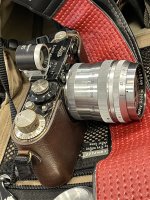Nitroplait
Well-known
This one just returned from service.
Beautiful Leica II that started out as a Leica IA in 1929.
The tech estimates the conversion took placed in the first half of 1933.
The lens is original as it does not have a serial number. It also have the slightly shorter barrel, typical of converted Elmars. The focusing tab has stamped a "3", which means that the real focal length is 48.6mm.
The only thing remaining from the original camera, besides the serial number, is the optical assembly. The rest is replaced, which makes you wonder about the economical sense it made to send it to the factory to have it "converted" rather than just buying a new Leica II and sell the old Leica IA.

Beautiful Leica II that started out as a Leica IA in 1929.
The tech estimates the conversion took placed in the first half of 1933.
The lens is original as it does not have a serial number. It also have the slightly shorter barrel, typical of converted Elmars. The focusing tab has stamped a "3", which means that the real focal length is 48.6mm.
The only thing remaining from the original camera, besides the serial number, is the optical assembly. The rest is replaced, which makes you wonder about the economical sense it made to send it to the factory to have it "converted" rather than just buying a new Leica II and sell the old Leica IA.















